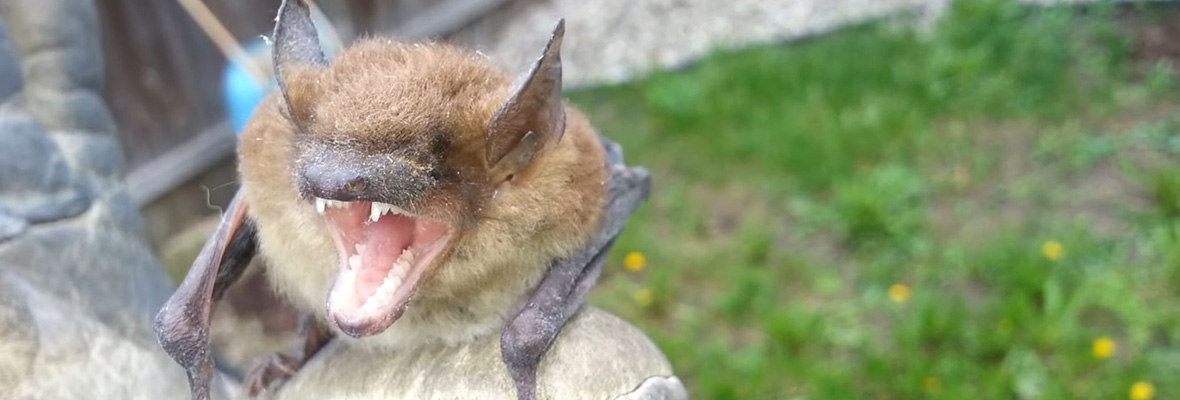An Introduction to the Big Brown Bat
The Big Brown Bat is also known as Eptesicus fuscus, and is like the Little Brown Bat, only bigger. (The name gives it away, really, right?) This particular bat species is not an animal of concern by any means, found almost everywhere across the United States and classed as a pest bat species in many States.

What Does the Big Brown Bat Look Like?
One of the larger bat species, the Big Brown Bat looks very much like the bigger, bolder, braver cousin of the Little Brown Bat, black, grey, brown or tones of all of them together covering its fur, with wings and a nose that is usually darker than the rest of the body. Again, like most other bat species, the underbelly of this animal is lighter in color than the rest.
Tipping the scales at about 25 grams, the bat will usually fall somewhere between 10 and 20 grams, with a wingspan of 30-35cm. The total length of the animal is below 13cm in most cases, making it large, but still not the largest.
You can tell males from female Big Brown Bats if you get a chance to see them close – the females are often a little bigger than the males, and older bats also have lighter fur too. Young bats tend to have very dark, almost black fur.
Where Does the Big Brown Bat Live?
You'll find the Big Brown Bat in almost every place across North America and Canada, and there have even been colonies of them found in slightly hotter places too – some parts of South America and even the Caribbean too. Brazil, Venezuela, Colombia … These bats like a warmer climate.
In the wild (rural areas), Big Brown Bats are found in deciduous forests and cultivated fields, but they seem to have quite a liking for areas where people are found now. In their defense, bats are fast running out of wild places to live. Caves, crevices in rocks, and all hollows and cavities in trees are favored wild spots, but moving closer to us and you'll find them in old barns and abandoned or dilapidated buildings, attics, churches and cathedrals, and other man-made structures.
What Does the Big Brown Bat Eat?
Most bat species eat insects and the Big Brown Bat is no exception to the rule. This particular species enjoys eating things that would cause you a problem — moths, wasps, flying ants, etc. In fact, bats are responsible for keeping the insect population down, giving you one massive reason why losing any of the bat species would be such a huge tragedy. We would definitely suffer as a result.
When Are Big Brown Bats Born?
In the later part of spring, heading into summer, female bats will have one or two young bats, called pups. In rare instances, females may have three or four bats, but four is incredibly rare, and when two or three bats are born, there is a chance that one of them will not be strong enough to make the journey into adulthood. If one of the bats is sick or not progressing as fast as the rest, it is possible that a female will “sacrifice” the weak pup. She would much rather focus all of her attention on the bat babies that have the most chance of survival, rather than wasting food and other things on a pup that is probably going to die at some point.
Pups can fly at four weeks of age, progressing very quickly from the bald and pink babies that were initially born. By the time they reach four to six weeks of age, the youngsters are almost the same size as their adult counterparts, although the fur will still be a much darker color as previous mentioned.
At about three months of age, the pups are pretty much weaned — they no longer need their mothers to feed them. Baby girls stay with their mothers for much longer than the males do — they'll flee the roost (as they say) as early as possible. They stay so hidden and solitary throughout the warmer, summer months that we actually don't know an awful lot about them as a species, but the women will stick together. During the spring and summer they will come together in maternity roosts — to give birth to their pups and then nurse them until they are old enough to live their own lives. During the winter, those bats who do not migrate to somewhere warmer will hibernate (go into a state of “sleeping” torpor). This will usually be large groups of females again, but males will join this party.
In total, the Big Brown Bat is only expected to last for a maximum of five years, but this is a rare age. Disease, people, predators … There are a lot of ways for bats to die, and many of them won't get to the second year of their life.
Go back to the Bat Removal home page or email us for more info about An Introduction to the Big Brown Bat

